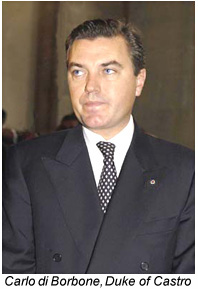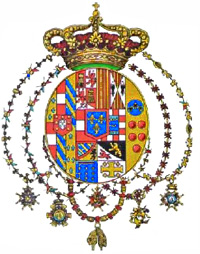Carlo di Borbone - Best of Sicily Magazine (original) (raw)

 On an autumn afternoon, greeting students and local dignitaries at Sciacca, his slightly French accent and the dark neck tie bearing a repeating pattern of fleurs-de-lis are the only subtle reminders of a royal French lineage. His pretty wife, raised in Italy, France and the United States, speaks Italian, French and English with no trace of a foreign accent, and seems equally at home with the local crowd. Born in the South of France in 1963, Carlo di Borbone (de Bourbon) is married to the former Camilla Crociani and resides in Rome and Monaco. He is the son of Prince Ferdinando, Duke of Castro, who is head of the Royal House of the Two Sicilies, Sicily's own royal family, which ruled until 1860 from Naples. Prince Ferdinando and his son are descended in the male line from King Ferdinando II, who reigned until 1859. Prince Carlo, who as heir apparent to headship of his dynasty bears the title Duke of Calabria, visits Sicily occasionally. In Sicily, their former royal properties, the Chinese Villa in Palermo and the Hunting Lodge at Ficuzza (near Corleone), are local symbols of the dynasty's legacy. There is no real possibility that the Bourbons (or, for that matter the Savoys, who ruled all of Italy from 1860 until 1946) will ever be restored to a throne, but their cultural role in Sicily, as living links to another era, is still an important one, and their coat of arms is increasingly seen in Sicilian circles. The Bourbons' charitable organization, the Constantinian Order of Saint George, is represented in Sicily, throughout Europe, and also in London and New York. His Highness was interviewed for Royalty magazine. (Editor's Note: Since this interview, Prince Ferdinando has died and Carlo is now Head of the House of the Two Sicilies.)
On an autumn afternoon, greeting students and local dignitaries at Sciacca, his slightly French accent and the dark neck tie bearing a repeating pattern of fleurs-de-lis are the only subtle reminders of a royal French lineage. His pretty wife, raised in Italy, France and the United States, speaks Italian, French and English with no trace of a foreign accent, and seems equally at home with the local crowd. Born in the South of France in 1963, Carlo di Borbone (de Bourbon) is married to the former Camilla Crociani and resides in Rome and Monaco. He is the son of Prince Ferdinando, Duke of Castro, who is head of the Royal House of the Two Sicilies, Sicily's own royal family, which ruled until 1860 from Naples. Prince Ferdinando and his son are descended in the male line from King Ferdinando II, who reigned until 1859. Prince Carlo, who as heir apparent to headship of his dynasty bears the title Duke of Calabria, visits Sicily occasionally. In Sicily, their former royal properties, the Chinese Villa in Palermo and the Hunting Lodge at Ficuzza (near Corleone), are local symbols of the dynasty's legacy. There is no real possibility that the Bourbons (or, for that matter the Savoys, who ruled all of Italy from 1860 until 1946) will ever be restored to a throne, but their cultural role in Sicily, as living links to another era, is still an important one, and their coat of arms is increasingly seen in Sicilian circles. The Bourbons' charitable organization, the Constantinian Order of Saint George, is represented in Sicily, throughout Europe, and also in London and New York. His Highness was interviewed for Royalty magazine. (Editor's Note: Since this interview, Prince Ferdinando has died and Carlo is now Head of the House of the Two Sicilies.)
Your family was forced to go into exile during the Risorgimento (the unification of Italy) in the last century. What were the reasons behind your ancestors' overthrow? Why did they leave?
"The reasons for the loss of the Throne of the Two Sicilies were essentially external. The Kingdom suffered an unforeseen military invasion which, especially in its early phases, was not  adequately responded to because a number of high-ranking Neapolitan officers had been bribed by the Piedmontese - a fact which has been addressed by historians in recent years. King Francesco II and his consort, Queen Maria Sofia, though they were both very young at the time, fought until the end. They led the defense at the siege of Gaeta to uphold the independence of the Kingdom and the name of the dynasty, as well as the honour of the Neapolitan Army. The great majority of the population remained loyal to their legitimate Sovereign, and in fact the Piedmontese forces were hindered for years by an armed resistance which was eventually quashed, but only with a great deal of bloodshed. The true motives for the conquest of the South are attributed to the ambitions of the comparatively small Kingdom of Sardinia, which happened to have had a large national debt. This debt was finally paid with monies confiscated from the South."
adequately responded to because a number of high-ranking Neapolitan officers had been bribed by the Piedmontese - a fact which has been addressed by historians in recent years. King Francesco II and his consort, Queen Maria Sofia, though they were both very young at the time, fought until the end. They led the defense at the siege of Gaeta to uphold the independence of the Kingdom and the name of the dynasty, as well as the honour of the Neapolitan Army. The great majority of the population remained loyal to their legitimate Sovereign, and in fact the Piedmontese forces were hindered for years by an armed resistance which was eventually quashed, but only with a great deal of bloodshed. The true motives for the conquest of the South are attributed to the ambitions of the comparatively small Kingdom of Sardinia, which happened to have had a large national debt. This debt was finally paid with monies confiscated from the South."
Is it true that your ancestor, Ferdinando II, was offered the throne of a united Italy?
"King Ferdinando II was offered the Throne but he adamantly refused because to have accepted would have been contrary to his moral principles. Despite having the largest Italian army at his disposal, he didn't want to displace the Pope and the other Italian sovereigns who ruled friendly nations. Some have suggested how differently Italian history might have developed had Italy been united under the Bourbons. The long political conflict between clericals and anticlericals might never have occurred. The emigration, for economic reasons, of millions of southerners would not have been necessary. The nation's tragic participation in the First World War never would have taken place and, consequently, Fascism - with its alliance to Nazism - might never have been spawned. But history is based on what actually happens, not what might have happened."
What effect has exile had on the fortunes of your family? Have you kept close relations with your would-be subjects?
"Economically speaking, my family lost all its assets in the Kingdom of the Two Sicilies, even those that were strictly personal. We didn't remove any art treasures or financial assets from Naples. The only material assets that remained in the family's possession were those inherited from our Farnese forebears and present in the Papal State. As far as relations with the residents of the former Kingdom are concerned, they have always been very good. The southerners have never forgotten the close ties to their former sovereigns and their descendants."
Your branch of the ubiquitous Bourbons ruled over the south of Italy for many years. How did they arrive there?
"The first Bourbon actually to reign in the Mezzogiorno - the South of Italy - was King Carlo, son of Philip V of Spain and great-grandson of the Sun King. He established the autonomy of the South in 1734, following centuries of Vice Regency. At the end of a successful reign in Naples, he ascended the Spanish Throne as Carlos III, and the subsequent Spanish sovereigns are descended from him. His third-born son, Ferdinando, who succeeded him, reigned until 1825 and by that time was considered the doyen of European monarchs."
There's a fraternal attitude among Italian royal families today, and the Savoys attended your wedding in Monte Carlo a few years ago. But with the eventual unification under the Savoy dynasty, what were your family's relations like with the House of Savoy in the past?
"Our last King, Francesco II, was the son of a Savoy, the Venerable Maria Cristina, but it's obvious that following the end of the Kingdom of the Two Sicilies our relations with the Savoys were unfortunately marked by a degree of antipathy. These relations have improved during the twentieth century. One of my father's cousins, Princess Lucia, married Eugenio di Savoia, then Duke of Ancona, in 1928. Another cousin, Prince Casimiro, married Princess Maria Cristina of Savoy-Aosta in 1967. A formal reconciliation took place between my father and the last King of Italy, Umberto II, who exchanged honours in the highest dynastic orders. And it mustn't be forgotten that during the 1930s Umberto made a great effort for the interment of the remains of Francesco II and Maria Sofia in Italy."
The Italian Republic, although appearing united from the outside, contains several separatist movements. There is a strong neo-Bourbon movement in the South. Do you support its political aims, or do you see it as more of way of a poorer, sometimes forgotten region to assert its historic and cultural roots?
"The actual secessionist movements that have appeared in Italy in recent years are all based in the North. The Neo Bourbon Movement and similar southern organisations are merely seeking to salvage the dignity of the South, to preserve a culture and a historical memory that was erased or at least obscured. It is only under these conditions that I can view the activities of these movements with a supportive attitude. I don't believe that the division of Italy is at all possible or practical today, when national barriers are falling in the interest of a united Europe. A federal approach seems far more likely, and it certainly has historical, political and economic precedents in some of the world's largest nations."
The last King and Queen were reburied in Naples in 1984. What were the circumstances surrounding that event?
"The last King and Queen of the Two Sicilies died in exile. In 1939, thanks to the efforts of Umberto of Savoy, who was then Prince of Piedmont, their remains were returned to Italy, where they were interred at the Church of the Holy Spirit of the Neapolitans - traditionally the national church of the Southern community in Rome - where their only child, little Maria Cristina, was entombed. Of course, it had always been hoped that the last King might come to rest in the family chapel in Naples. Finally, in 1984, the Constantinian Order of Saint George made good on this vow with a memorable ceremony that brought the heads of a number of royal families to Naples. The coffin of Francesco II was placed in the family tomb surrounded by small vials containing soil drawn from each of the cities of the Kingdom of the Two Sicilies. Since then, the Royal Chapel, in the Basilica of Santa Chiara, has housed the remains of all the monarchs of the House of Bourbon of the Two Sicilies."
About the Author: Anthony Bailey is the author of numerous articles dealing with European royalty.